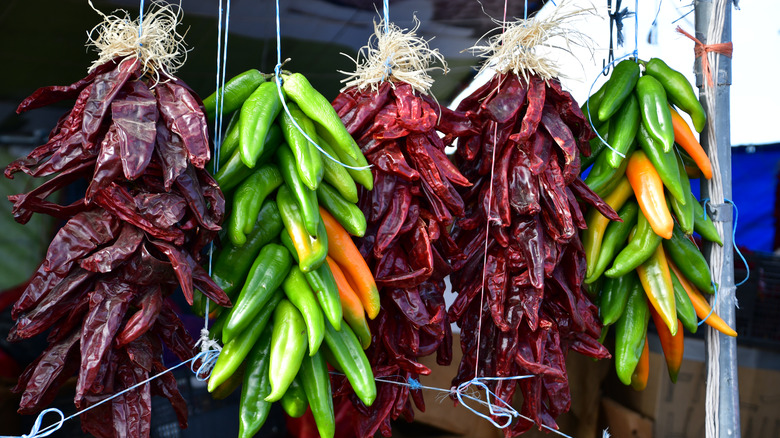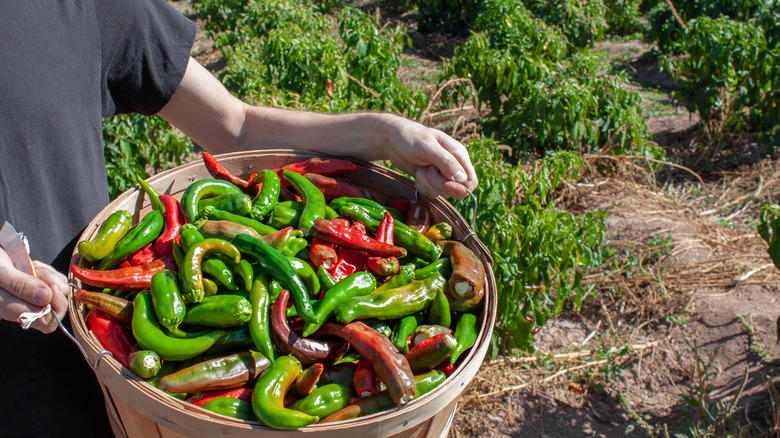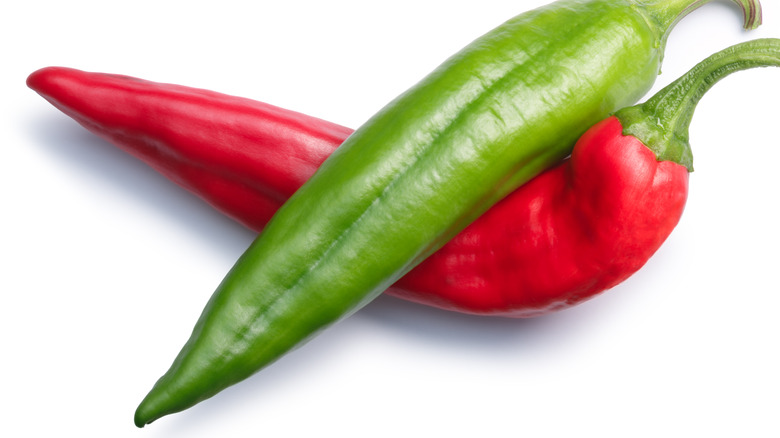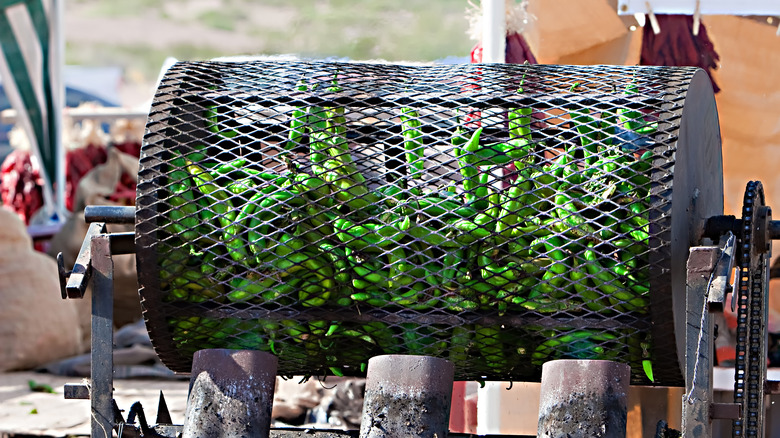The Flavor Difference Between Green And Red Hatch Chiles
Stroll the streets of any New Mexico town during the fall and you're likely to find ristras made from red chiles swaying in the Southwestern breeze. We aren't exaggerating, because New Mexicans are the largest group of United States chile consumers per capita. These strung peppers aren't just for decoration but are also a favored way to cure freshly harvested hatch chiles. As Eric Romero, a professor at New Mexico Highlands University, told New Mexico Magazine,"It creates a community of people. It's who we are. We're chileros! We are chile. We die for chile. We put it on pancakes."
These flavorful chiles are harvested from early August through late September (via Chili Pepper Madness) and festivals like the Santa Fe Wine and Chile Fiesta and Hatch Chile Festival celebrate the year's bounty by giving attendees this true taste of New Mexico. Whether it's the hay-like grassy aromas from the green chiles roasting, or the "did you try the red ones from booth 88" type of enthusiasm coming from the crowd, fall is definitely in the New Mexico air. The hatch chile is unique to New Mexico (per Food & Wine) and undoubtedly delicious, but one question remains: "Which is better – the green or red ones?"
Where and how they grow
Related to the more commonly known Anaheim pepper, the National Park Service reports that the wild ancestral form of these capsicums probably came from the areas of Bolivia and Peru more than 7,000 years ago. Today, hatch chiles stand as a symbol of New Mexico culture and are unique to the Hatch Valley. Just like how true champagne can only come from Champagne, France, New Mexico passed a law in 2012 that ensures that only chiles grown in New Mexico can be labeled as such, per Chile Pepper Madness.
Ever visited a winery while traveling and found the wine unparalleled? The same reasoning can be applied to Hatch chiles. When we travel, PBS suggests it's the sense of place (or terroir) — may it be the people, the minerals in the soil, or even the microclimate of a geographic location — that create those special memories attached to foods like this New Mexican treasure. Known for its rich, volcanic soil, the valley along the Northern Rio Grande (a NPS heritage area) presents hot days and cold nights creating a terroir suitable for growing peppers prolifically. Nate Cotanch of Zia Green Chile Company told Food & Wine, "I like to think that the Hatch Valley is to chile peppers what the Napa Valley is to grapes."
The difference between green and red hatch chiles
The main difference between the many varieties of Hatch green and red chiles is a matter of time, according to The Spruce Eats. The green ones are considered a vegetable, so they are harvested early and roasted. But, allowed to ripen, the red ones are most commonly strung into ristras and hung to dry prior to grinding into a spice. About twenty percent of the state's chiles are harvested green for the fresh market, per The Chile Pepper Institute.
"When picked early and then roasted, Hatch green chiles have a very smoky, upfront flavor," Nate Cotanch of Zia Green Chile Company told Food & Wine. "Then as the chiles mature and turn red, they develop a slightly sweeter flavor profile and a more earthy underlying taste." With a Scolville score between 1,500 and 2,500 units, The Fresh Market likens the hatch chile's heat intensity to a poblano pepper. Though, as Cotanch explained, the hatch chile's fame comes from its flavor as opposed to its heat.
Where to find them and how to use them
If you want to eat like a local and can't make it to one of the numerous New Mexican chile festivals, James-Beard Award-winning chef Fernando Olea of Sazón in Santa Fe invites you to taste this essential component in his array of moles, including his "New Mexican Mole." If you can't land on green or red, just order your dish Christmas-style, which comes with both, according to New York Daily News.
Fresh and preserved products are also available online from shops like Cotanch's Zia Hatch Chile Company, and the Hatch Chile Store. If you're unsure of a store's authenticity, search for the New Mexico True Certified label to make sure you're getting the real deal.
Once you acquire your fresh chiles, you can easily roast them at home in an oven, on top of a gas stove, or on an outdoor grill. If you're working with dried chiles, you can make a sauce with them if you rehydrate 12-14 pods in warm water for about 30 minutes before simmering for 10 minutes, straining, and adding desired aromatics, per NPS. Or, opt to use it as a spice in recipes like this Carne Adovada: New Mexico Red Chile Pork Stew recipe from The Spruce Eats.
Now that you know that the differences are pretty simple, you just may find yourself channeling Romero (the aforementioned professor at New Mexico Highlands University) with your undying love for Hatch chiles no matter their hue.



